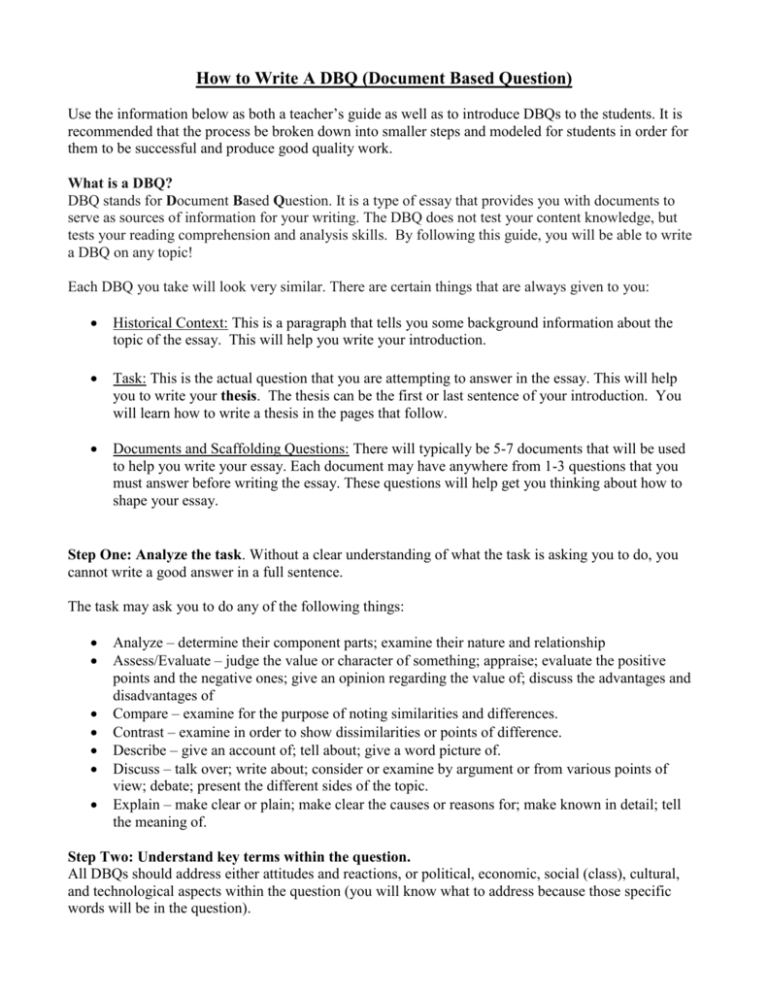How to Write a DBQ Essay: Guide & Organizer
advertisement

How to Write A DBQ (Document Based Question) Use the information below as both a teacher’s guide as well as to introduce DBQs to the students. It is recommended that the process be broken down into smaller steps and modeled for students in order for them to be successful and produce good quality work. What is a DBQ? DBQ stands for Document Based Question. It is a type of essay that provides you with documents to serve as sources of information for your writing. The DBQ does not test your content knowledge, but tests your reading comprehension and analysis skills. By following this guide, you will be able to write a DBQ on any topic! Each DBQ you take will look very similar. There are certain things that are always given to you: Historical Context: This is a paragraph that tells you some background information about the topic of the essay. This will help you write your introduction. Task: This is the actual question that you are attempting to answer in the essay. This will help you to write your thesis. The thesis can be the first or last sentence of your introduction. You will learn how to write a thesis in the pages that follow. Documents and Scaffolding Questions: There will typically be 5-7 documents that will be used to help you write your essay. Each document may have anywhere from 1-3 questions that you must answer before writing the essay. These questions will help get you thinking about how to shape your essay. Step One: Analyze the task. Without a clear understanding of what the task is asking you to do, you cannot write a good answer in a full sentence. The task may ask you to do any of the following things: Analyze – determine their component parts; examine their nature and relationship Assess/Evaluate – judge the value or character of something; appraise; evaluate the positive points and the negative ones; give an opinion regarding the value of; discuss the advantages and disadvantages of Compare – examine for the purpose of noting similarities and differences. Contrast – examine in order to show dissimilarities or points of difference. Describe – give an account of; tell about; give a word picture of. Discuss – talk over; write about; consider or examine by argument or from various points of view; debate; present the different sides of the topic. Explain – make clear or plain; make clear the causes or reasons for; make known in detail; tell the meaning of. Step Two: Understand key terms within the question. All DBQs should address either attitudes and reactions, or political, economic, social (class), cultural, and technological aspects within the question (you will know what to address because those specific words will be in the question). Step Three: Pay attention to the time period of the documents. Step Four: Read the documents and answer the scaffolding questions. Read the documents carefully and answer the scaffolding questions (additional questions that make you think critically about the topic). Each document may have 1-3 questions that follow that you must answer before writing the essay. These questions will help get you thinking about how to shape your essay and will help in writing the thesis statement. Step Five: Develop a Thesis. This is your opinion on the given topic. Theses must be stated in your opening paragraph. It is normally the last sentence in your opening paragraph. The reader must immediately know your position on the question before reading the rest of your essay. For full credit on your essays you must clearly state your position. How to write a thesis statement: 1. State your opinion on the topic. Your thesis must argue a position and state your opinion. 2. A DBQ thesis should be one sentence. 3. Use the documents in the DBQ to come up with three supporting reasons that help explain your position. Your DBQ can use outside information, but you must use all of the documents in the DBQ to help explain your answer. Tips for writing a successful DBQ thesis: If you are stuck turning your thesis into one sentence, use “because” as a link between your opinion statement and the three reasons why your opinion is correct. These statements do a great job at condensing the paper's argument into a single sentence. They are direct and answer a question by offering ways to understand the subject matter. In fact, viewing a thesis statement as an answer to the question your paper explores is a great framework with which to build your thesis. Example thesis statements: Hemingway's stories helped create a new prose style by employing extensive dialogue, shorter sentences, and strong Anglo-Saxon words. The Walking Dead is the best show on TV due to its graphic but well placed violence, outstanding make up, and credible actors Step Six: Outline Your Essay: Before beginning the essay, you should always create an outline. Attached at the end are two different DBQ organizers that can help to organize the information you want to use in your essay. The outlines below are suggestions and may need to be changed based on the DBQ assigned. You can choose to set up the essay outline to fit your needs as long as you keep the same elements. Step Seven: Write the Introductory Paragraph. Start with a sentence that grabs the reader's attention – this can be from historical background State your thesis Explain what you are going to talk about (lead your reader through your essay) Do not explain the historical background – the graders already know the background (they gave it to you) Step Eight: Write the Body Paragraphs. Analyze, analyze, analyze. Do not just state facts. Tie them to the thesis and explain how they prove the thesis. It is important that you support your thesis while referencing the documents. When referencing the documents make sure to analyze what the document or person is saying and, if possible, why they are saying what they are saying (explain their background). When using the documents do not quote directly – remember you are only referencing them, as you would do in a term paper. If you decide to quote one of the documents directly do it in a meaningful way. This usually means quote sparingly (quote only part of the document, and only do this method with one or two documents). Be sure to cite it properly. Name the person and what they are in your sentence. At the end of each sentence write the document number in parentheses in abbreviated form. e.g. Peter Kropotkin, an anarchist, mocked the idea of “order” by illuminating the disease-ridden peasants, stolen peasant’s crops, & uncultivated land (Doc 4). Do not just list the documents as they are presented in the DBQ. You must have some kind of analysis involved with them. Facts should be organized in logical sequence Each set of facts should be in a separate paragraph Refute arguments contrary to your thesis if you can Step Nine: Write the conclusion. The conclusion should bring the reader back to your thesis and the question. No new information should be added! DBQ Tips: Don't just summarize each document. Tie them all together. Make sure to make an outline to guide your essay with main ideas or topics of importance. Follow your outline, but beef up the main points in the essay. Add relevant outside information. Explain why three of the articles might be biased (doing this will get you an extra point on the DBQ). For students who get timed, try to practice at home by timing yourself. Document # and Description Document Information Document # Describe what the document is about: Brief description of the document: *Use answers from the DBQ questions for document information. *Make sure you focus on answering the task (essay question) Document # ‘s _______ (Body Paragraph) Document #’s _______ (Body Paragraph) Document # ‘s _______ (Body Paragraph) Document # ‘s _______ (Body Paragraph) Outside Information **Make sure to answer the TASK (essay question) with outside information. -Bring in outside information related to that particular document. DBQ Essay Organizer Thesis Statement: Body Paragraphs: (There should be 1 box for each task/reason) Doc #’s Details/examples from the doc and analysis Outside Information Doc #’s Details/examples from the doc and analysis Outside Information Doc #’s Details/examples from the doc and analysis Outside Information Conclusion: (Restate the thesis & information from introduction to end your essay.)







